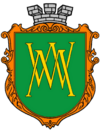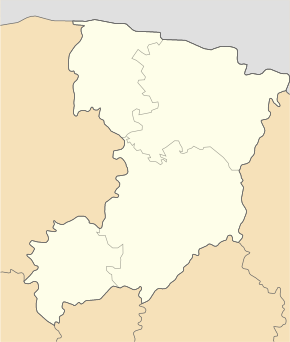Misoch
| Misoch | ||
| Мізоч | ||

|
|
|
| Basic data | ||
|---|---|---|
| Oblast : | Rivne Oblast | |
| Rajon : | Sdolbuniv district | |
| Height : | no information | |
| Area : | 16.24 km² | |
| Residents : | 3,550 (2011) | |
| Population density : | 219 inhabitants per km² | |
| Postcodes : | 35740 | |
| Area code : | +380 3652 | |
| Geographic location : | 50 ° 24 ' N , 26 ° 9' E | |
| KOATUU : | 5622655400 | |
| Administrative structure : | 1 urban-type settlement , 3 villages | |
| Mayor : | Bohdan Pochyljuk | |
| Address: | вул. Липки 12 35740 смт. Мізоч |
|
| Statistical information | ||
|
|
||
Misoch ( Ukrainian Мізоч ; Russian Мизоч , Polish Mizocz ) is an urban-type settlement in the western Ukrainian Rivne Oblast with about 3500 inhabitants. It is located on the Stubaska River , about 20 kilometers southwest of the Rajons capital Sdolbuniv and 27 kilometers southwest of the Oblast capital Rivne .
The settlement council also includes the villages Klopit ( Клопіт ), Misotschok ( Мізочок ) and Oserko ( Озерко ).
history
The place was mentioned in writing for the first time in 1322, was granted Magdeburg city charter in 1759 and was part of the Polish-Lithuanian aristocratic republic in the Volhynian Voivodeship . After the third partition of Poland , he came to the newly founded Volhynia governorate as part of the Russian Empire .
The first Jewish families settled here in the 18th century. In the 1920s they made up around half of the local population. Since 1940 the village has had urban-type settlement status. Even before the First World War, a railway connection to the local sugar factory was built from the Lviv – Sdolbuniw railway line , and this connection still exists today.
German mass murders in World War II
In October 1942, mass shootings by the security police and the SD took place near the village ( Einsatzgruppen , Jewish residential area Misotsch , uprising against the shootings), which, along with other mass shootings in the area, wiped out the Jewish community of Misotsch. In February 1944, the Red Army ended the German occupation in Misotsch and the former Polish city remained with the Soviet Union.
Jewish pogrom in Misoch
Immediately after the armed forces marched in on June 27, 1941, riots began against Jews. At a Jewish funeral, Ukrainians threw stones at the mourners. Several Jews were murdered in a pogrom on June 29, 1941. In 1942 Jews from Misoch, Sdolbuniv and Ostroh were forced to move into ghettos. In August the Jewish butcher Sejde Gelman was hanged on the market square in Misoch.
Hermann Friedrich Graebes , chief engineer at the Josef Jung company, tried with great personal commitment to save Jews, including 60 Misotscher.
Mass shootings by Einsatzgruppen of the SS and SD
At the end of August 1942, at a meeting of the area commissioners with the commander of the security police and the SD, the decision to kill all Jews in Volhynia was decided.
On October 13, 1942, at 3:30 a.m., the Misoch ghetto was cordoned off. By order of the Germans, the prisoners had to assemble in the market square. As early as October 13th, there was evidence that hundreds of murdered Jews lay on the side of the road. Those gathered on the market square were herded to the football field, and according to different memories, they were already led to the shooting site. On the morning of October 14, the killing squad from Task Force C arrived. The detained Jews were driven in groups into a hollow and forced to take off their clothes. On October 14, children, women and men were shot dead in the neck. Some victims had to walk over a plank beforehand and then fell hit into prepared pits, while others were forced to lie down on the dead or injured before the murder squad shot them too. Soviet prisoners of war were among the 1,500 people shot in the village on October 14, 1942 and around 3,500 in January 1943 .
The Jews were hunted by the non-Jewish population and the Germans, the clothes of the dead were collected and the former ghetto was plundered, while surviving local Jews sought refuge in the area. After the Ukrainian insurgent army grew in popularity at the end of 1942, it fought against the Germans, Polish and Soviet partisans and murdered hidden Jews, whom it caught.
Processing of the mass shootings
Five photographs of the mass shootings of exposed, defenseless women in Misotsch have survived. According to the investigations of the Federal German judiciary, it can be regarded as proven that the German gendarme Gustav Hille took them in. Three contemporary witnesses mention him by name in connection with the evacuation of the ghetto in 1942. His behavior during the events is no longer investigated in the 1963 trial against German police officers and members of the civil administration in the Sdolbuniw area because he had already died.
An investigative commission of the Soviet Union investigated after the end of the German occupation because of the crimes. The shootings in the Zdolbunów area were mentioned in a testimony by Hermann Gräbe in the Nuremberg trial of the main war criminals . In the Federal Republic of Germany, legal reappraisal only began at the end of the 1950s. A trial against members of the KdS (commander of the security police and SD) Rivne did not take place.
Sofia Gorstein, who survived from October 1942 to July 1943 with the help of Sidor and Justina Slobodjuk and their daughter Maria after she escaped from the burning ghetto, achieved the honor of the family as Righteous Among the Nations .
A memorial was erected on site in the 1980s. The documentation of the crimes is thanks to the historian Roman Michalschuk, who published his results in a book in 2010. Research in 2007/08 also started from Yahad - in Unum (Hebrew and Latin common) .
Misotsch is the focus of the Mass Shootings exhibition shown in Berlin, Cologne and Ludwigsburg 2016-2018 . The Holocaust between the Baltic Sea and the Black Sea 1941-1944 . The journalist Felix Sven Kellerhof sums this up in the following sentence: In contrast to the giant massacre of Babyn Yar, Misotsch was a normal crime that was almost everyday in German-occupied East Central Europe.
post war period
From 1939/1945 to 1959 the place was the center of the Misotsch Rajon of the same name . In 1945 the village finally came to the Soviet Union and was incorporated into the Ukrainian SSR . Mizoch has been part of Ukraine since its independence in 1991.
literature
- Mizocz , in: Guy Miron (Ed.): The Yad Vashem encyclopedia of the ghettos during the Holocaust . Jerusalem: Yad Vashem, 2009 ISBN 978-965-308-345-5 , p. 486
- The destruction of a community - Mizocz in Volhynia 1941-1944, in: Mass shootings. The Holocaust between the Baltic Sea and the Black Sea 1941-1944 (exhibition volume) (ed.): Foundation Memorial for the Murdered Jews of Europe, Foundation Topography of Terror, ISBN 978-3-941772-22-9 , p. 316
Web links
- Mizocz . In: Filip Sulimierski, Władysław Walewski (eds.): Słownik geograficzny Królestwa Polskiego i innych krajów słowiańskich . tape 6 : Malczyce – Netreba . Walewskiego, Warsaw 1885, p. 513 (Polish, edu.pl ).
- wsw.org: Verena Nees: mass shootings. The Holocaust between the Baltic Sea and the Black Sea 1941-1944 , Oct. 22, 2016, accessed on April 8, 2018
- welt.de: Felix, Sven Kellerhof: Thousandfold murder as amusement , published on September 30, 2016, accessed on April 8, 2018
Individual evidence
- ↑ a b Local history of Misoch in the history of the cities and villages of the Ukrainian SSR ; accessed on April 7, 2018 (Ukrainian)
- ↑ a b c d e f g h i j k l Mass shootings. The Holocaust between the Baltic Sea and the Black Sea 1941-1944, pp. 35–51
- ↑ mass shootings. The Holocaust between the Baltic Sea and the Black Sea 1941-1944, pp. 39,47
- ↑ mass shootings. The Holocaust between the Baltic Sea and the Black Sea 1941-1944, p. 71.
- ↑ mass shootings. The Holocaust between the Baltic Sea and the Black Sea 1941-1944 . S. 42, 69 .
- ↑ Weblink Kellerhof


